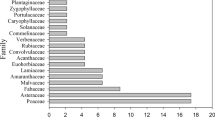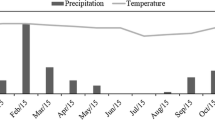Abstract
The potential of allye cropping systems to sustain a high productivity with low external inputs and the reduction of maize/weed competition through weed suppression in different alley cropping and sole-cropped mulched systems was studied in Costa Rica at CATIE. Data were recorded eight years after establishment of the experiment. Plant residues ofErythrina poeppigiana trees (10 t/ha dry matter) planted at 6 by 3 m reduced weed biomass by 52%, whileGliricidia sepium trees (12 t/ha dry matter) planted at 6 by 0.5 m reduced weed biomass by 28%, in comparison to controls.Erythrina had a considerable impact on grass weeds, whileGliricidia reduced the incidence of some dicot weeds. Weed competition significantly reduced maize yield in all systems. Nevertheless weed suppression contributed to the higher maize grain yield underErythrina andGliricidia alley cropping of 3.8 t per hectare as opposed to the unmulched control yield of 2.0 t per hectare.
Similar content being viewed by others
References
Adejuwon JO and Adesina FA (1990) Organic matter and nutrient status of soils under cultivated fallows: an example ofGliricidia sepium fallows from South Western Nigeria. Agroforestry Systems 10: 23–32
Adesina FA (1988)Developing suitable agroforestry systems in the tropics: an example of local agroforestry techniques from South Western Nigeria. Discussion Papers in Geography No 37, University of Salford, United Kingdom
Akobundu IO (1980)Live mulch: a new approach to weed control and crop production in the tropics. British Crop Protection Conference — Weeds, 1980, Research Reports Vol 2, pp 377–382.
Bhandari DC and Sen DN (1979) Agroecosystem analysis of the Indian arid zone I.Indigo fera cordiflora as a weed. Agro-Ecosystems 5: 257
Budelman A (1988) The performance of the leaf mulches ofLeucaena leucocephala, Fleminga macrophylla andGliricidia sepium in weed control. Agroforestry Systems 6: 137–145
Budelman A (1990a) Woddy legumes as live support systems in yam cultivations. I. The tree crop interface. Agroforestry Systems 10: 47–59
Budelman A (1990b) Woody legumes as live support systems in yam cultivations. II. The yam-Gliricidia sepium association. Agroforestry Systems 10: 61–69
Derpsch R, Roth CH, Sidiras N and Köpke U (1988) Erosionsbekämpfung in Paraná, Brasilien: Mulchsysteme, Direktsaat und konservierende Bodenbearbeitung. Eschborn, Germany, Deutsche Gesellschaft für Technische Zusammenarbeit (GTZ) GmbH, 270 pp
Eßl A(1987) Statistische Methoden in der Tierproduktion. Wien, Österreichischer Agrar Verlag, 316 pp
Getahun A (1981) IITA/IDRC agroforestry trials. Progress report, August 1981
Haggar JP and Beer JW (1993) Effect on maize growth of the interaction between increased nitrogen availability and competition with trees in alley cropping. Agroforestry Systems 21: 239–249
Haggar JP, Tanner EVJ, Beer JW and Kass DCL (1993) Nitrogen dynamics of tropical agroforestry and annual cropping systems. Soil Biology and Biochemistry 25(10): 1363–1378
Holdrige LR (1977) Ecología basada en las zonas de vida. San José, Costa Rica IICA, 216 pp
Holm S (1979) A simple sequentially rejective multiple test procedure. Scandinavian Journal of Statistics 6: 65–70
IITA (1983) Agroforestry. In: IITA Annual Report for 1982 pp 153–159. International Institute of Tropical Agriculture (IITA), Ibadan, Nigeria
IITA (1986) Performance of woody species in alley cropping with food crops. In: Annual Report 1985, pp 29–30. International Institute of Tropical Agriculture (IITA), Ibadan, Nigeria
Inostrosa SI and Fournier O (1982) Efecto alelopático deGliricidia sepium. Revista de Biología Tropical (C.R.) 30 (1): 35–39
Jama B, Getahun A and Ngugi DN (1991) Shading effects of alley croppedLeucaena leucocephala on weed biomass and maize yield at Mtwapa, Coast Province, Kenya. Agroforestry Systems 13: 1–11
Kang BT, Sipkens L, Wilson GF and Nangju D (1981) Leucaena (Leucaena leucocephala (Lam) de Wit) prunings as nitrogen source for maize (Zea mays L.). Fertilizer Research (2): 279–287
Kass DL (1987) Alley cropping of annual food crops with woody legumes in Costa Rica. In: Beer JW, Fassbender HW and Heuveldop J, eds, Advances in Agroforestry Research, pp 197–214. CATIE, Turrialba, Costa Rica
Kass DL, Barrantes A, Bermudez W, Campos W, Jimenez J and Sanchez J (1989) Resultados de seis años de investigación de cultivos en callejones (Alley cropping) en ‘La Montaña’, Turrialba, Costa Rica. El Chasqui 19: 5–24
Klingman DL (1971) Measuring weed density in crops. In: Chiarappa L, ed, Crop Loss Assessment Methods, pp 3.1.5/1–3.1.5/6. FAO, Rome
Kreeb KH (1983) Vegetationskunde. Methoden und Vegetationsformen unter Berücksichtigung ökosystemischer Aspekte. Verlag Eugen Ulmer, Stuttgart, 331 pp
Lal R (1978) Influence of within- and between-row mulching on soil temperature, soil moisture, root development and yield of maize (Zea mays L.) in a tropical soil. Field Crop Research 1: 127–139
Michieka RW (1981) Weed research survey in Kenya. A report for the National Council for Science and Technology, Kenya, 8 pp
Nye PH and Greenland DJ (1960) The soil under shifting cultivation. Tech Comm No 51. Commonwealth Bureau of Soils, Harpenden, UK, 156 pp
Obando Guerrero L (1987) Potential alelopatico deGliricidia sepium (Jacq.) Steud sobre los cultivos de maíz y frijol y las malezas predominantes. Tesis Mg. Sci. CATIE, Turrialba, Costa Rica
Prinz D (1986) Ökologisch angepaßte Produktionssysteme. Erhaltung und Verbesserung der landwirtschaftlichen Produktivität in den Tropen und Subtropen. In: Rehm S, ed, Handbuch der Landwirtschaft und Ernährung in den Entwicklungsländern. Band 3, Grundlagen des Pflanzenbaus in den Tropen und Subtropen, pp 115–186. Eugen Ulmer, Stuttgart
Raintree JB and Warner K (1986) Agroforestry pathways for the intensification of shifting cultivation. Agroforestry Systems 4: 39–54
Rehm SH, ed (1986) Handbuch der Landwirtschaft und Ernährung in den Entwicklungsländern. Band 3: Pflanzenbau in den Tropen und Subtropen. Eugen Ulmer, Stuttgart, 480 pp
SAS (1987) PC DOS SAS/STAT Release 6.03, Cary, USA, SAS Institute Inc, 558 pp
Schauder A (1988) Mulch von Leucaena (Leucaena leucocephala (lam.) de Wit) im Alley cropping System: Auswirkungen auf Mikroklima, Boden und Ertrag von Mais (Zea mays L.) auf einer Terra fusca — Braunerde in Haiti. Diplomarbeit, Germany, Universität Bonn, 95 pp
STSC (1987) STATGRAPHICS, Vers. 2.6 User's Guide. Statistical Graphics Coorporation, USA
Tilman D (1988) Plant Strategies and the Dynamics and Structure of Plant Communities. Princeton University Press, New Jersey, 360 pp
Utz HF (1988) PLABSTAT — Ein Computerprogramm zur statistischen Analyse von pflanzenzüchterischen Experimenten. Institut für Pflanzenzüchtung, Saatgutforschung und Populationsgenetik der Universität Hohenheim, 24 pp
Walter H (1983) Weed management in the Philippines: report of seminars. Plits 1983/1 (1). Universität Hohenheim, Stuttgart, Germany, 184 pp
Yamoah CF and Burleigh JR (1990) Alley croppingSesbania sesban (L) Merill with food crops in the highland region of Rwanda. Agroforestry Systems 10: 169–181
Yamoah CF, Agboola AA and Mulongoy K (1986a) Decomposition, nitrogen release and weed control by prunings of selected alley cropping shrubs. Agroforestry Systems 4: 239–246
Yamoah CF, Agboola AA and Wilson GF (1986b) Nutrient contribution and maize performance in alley cropping systems. Agroforestry Systems 4: 247–254
Yamoah CF, Agboola AA, Wilson GF and Mulongoy K (1986c) Soil properties as affected by the use of leguminous shrubs for alley cropping with maize. Agriculture, Ecosystems and Environment 18(2): 167–177
Zadoks JC, Chang TT and Konzak CF (1974) A decimal code for the growth stages of cereals (maize, sorghum, foragegrass and dicotyledonous crops). Weed Res 14(6): 415–421
Zimdahl RL (1980) Weed-Crop Competition: A Review. International Plant Protection Center, Corvallis, Oregon, USA, 196 pp
Author information
Authors and Affiliations
Rights and permissions
About this article
Cite this article
Rippin, M., Haggar, J.P., Kass, D. et al. Alley cropping and mulching withErythrina poeppigiana (Walp.) O. F. Cook andGliricidia sepium (Jacq.) Walp.: effects on maize/weed competition. Agroforest Syst 25, 119–134 (1994). https://doi.org/10.1007/BF00705672
Issue Date:
DOI: https://doi.org/10.1007/BF00705672




